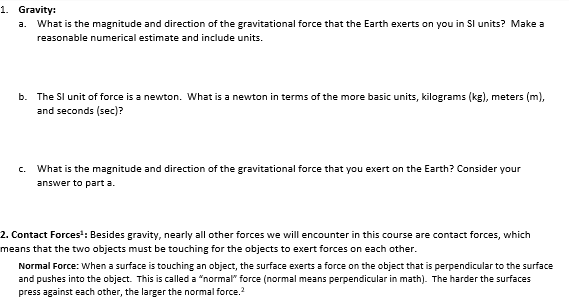1. Gravity: a. What is the magnitude and direction of the gravitational force that the Earth exerts on you in SI units? Make a reasonable numerical estimate and include units. b. The Sl unit of force is a newton. What is a newton in terms of the more basic units, kilograms (kg), meters (m), and seconds (sec)? c. What is the magnitude and direction of the gravitational force that you exert on the Earth? Consider your answer to part a.
1. Gravity: a. What is the magnitude and direction of the gravitational force that the Earth exerts on you in SI units? Make a reasonable numerical estimate and include units. b. The Sl unit of force is a newton. What is a newton in terms of the more basic units, kilograms (kg), meters (m), and seconds (sec)? c. What is the magnitude and direction of the gravitational force that you exert on the Earth? Consider your answer to part a.
Physics for Scientists and Engineers: Foundations and Connections
1st Edition
ISBN:9781133939146
Author:Katz, Debora M.
Publisher:Katz, Debora M.
Chapter7: Gravity
Section: Chapter Questions
Problem 64PQ
Related questions
Question

Transcribed Image Text:1. Gravity:
a. What is the magnitude and direction of the gravitational force that the Earth exerts on you in Sl units? Make a
reasonable numerical estimate and include units.
b. The SI unit of force is a newton. What is a newton in terms of the more basic units, kilograms (kg), meters (m),
and seconds (sec)?
What is the magnitude and direction of the gravitational force that you exert on the Earth? Consider your
answer to part a.
2. Contact Forces¹: Besides gravity, nearly all other forces we will encounter in this course are contact forces, which
means that the two objects must be touching for the objects to exert forces on each other.
Normal Force: When a surface is touching an object, the surface exerts a force on the object that is perpendicular to the surface
and pushes into the object. This is called a "normal" force (normal means perpendicular in math). The harder the surfaces
press against each other, the larger the normal force.²
Expert Solution
This question has been solved!
Explore an expertly crafted, step-by-step solution for a thorough understanding of key concepts.
This is a popular solution!
Trending now
This is a popular solution!
Step by step
Solved in 3 steps with 3 images

Knowledge Booster
Learn more about
Need a deep-dive on the concept behind this application? Look no further. Learn more about this topic, physics and related others by exploring similar questions and additional content below.Recommended textbooks for you

Physics for Scientists and Engineers: Foundations…
Physics
ISBN:
9781133939146
Author:
Katz, Debora M.
Publisher:
Cengage Learning

University Physics Volume 1
Physics
ISBN:
9781938168277
Author:
William Moebs, Samuel J. Ling, Jeff Sanny
Publisher:
OpenStax - Rice University

College Physics
Physics
ISBN:
9781938168000
Author:
Paul Peter Urone, Roger Hinrichs
Publisher:
OpenStax College

Physics for Scientists and Engineers: Foundations…
Physics
ISBN:
9781133939146
Author:
Katz, Debora M.
Publisher:
Cengage Learning

University Physics Volume 1
Physics
ISBN:
9781938168277
Author:
William Moebs, Samuel J. Ling, Jeff Sanny
Publisher:
OpenStax - Rice University

College Physics
Physics
ISBN:
9781938168000
Author:
Paul Peter Urone, Roger Hinrichs
Publisher:
OpenStax College